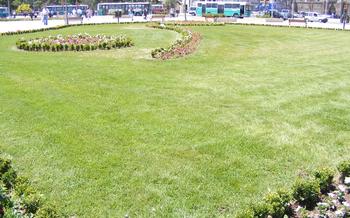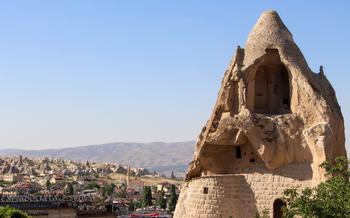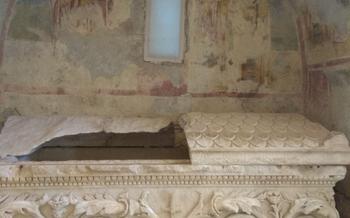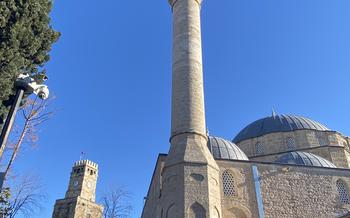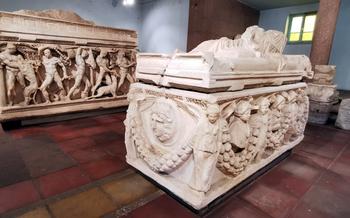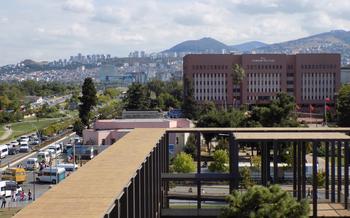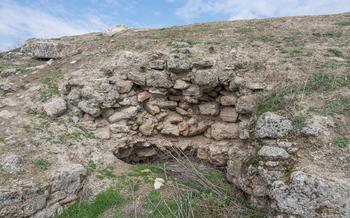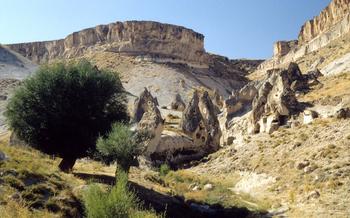
Mantıç Archaeological Site
- Historical Significance
- Mosaics and Frescoes: Artistic Masterpieces of Mantıç
- Architecture and Urban Planning
- Religious Sites
- Daily Life in Mantıç: A Glimpse into the Past
- The Theatre
- The Necropolis: A Journey Through Eternity
- The Museum
- Getting There:
- Entrance Fees and Visiting Hours
- Guided Tours and Audio Guides
- Photography and Videography
- Food and Refreshments: Tasting Local Delights
- Accessibility:
- Insider Tip:
Historical Significance
Mantıç, an ancient city in Kayseri, Turkey, holds significant historical value as a major commercial hub during the Roman and Byzantine periods. Archaeological excavations at the site have revealed stunning mosaics and artifacts that provide insights into the city's vibrant past. The presence of a Roman theatre and other notable structures further attests to Mantıç's importance as a cultural and administrative center. Its strategic location along trade routes facilitated the exchange of goods and ideas, contributing to the region's prosperity and development. Exploring Mantıç's rich history allows visitors to connect with the diverse civilizations that shaped this ancient city.
Mosaics and Frescoes: Artistic Masterpieces of Mantıç
The Mantıç Archaeological Site is renowned for its stunning mosaics and vibrant frescoes, which offer a glimpse into the artistic achievements of the Roman and Byzantine periods. The mosaic floors, meticulously crafted with tiny tesserae, depict a variety of subjects, from mythological scenes to everyday life. One particularly impressive mosaic showcases a bustling marketplace, with merchants, shoppers, and animals depicted in intricate detail. The walls of the ancient buildings are adorned with equally impressive frescoes, painted using a variety of techniques. These frescoes depict religious figures, historical events, and scenes from nature, adding color and life to the ancient city.
The artists of Mantıç employed various techniques to create these intricate artworks. Mosaics were made by arranging small pieces of colored stone, glass, or ceramic into a design, while frescoes were painted directly onto wet plaster. The use of vibrant colors and shading techniques brought these artworks to life, creating a sense of depth and realism. The mosaics and frescoes of Mantıç are not only aesthetically pleasing but also hold significant historical and cultural value. They provide valuable insights into the artistic styles, religious beliefs, and daily life of the people who once inhabited this ancient city.
Architecture and Urban Planning
Mantıç boasts a distinctive architectural style that blends Roman engineering with Hellenistic influences. Its buildings feature vaulted ceilings, arched doorways, and intricate stone carvings. The city's layout is organized in a grid-like pattern, with public spaces such as plazas and fountains strategically placed to enhance the urban environment.
The influence of Roman urban planning is evident in Mantıç's infrastructure. The city once had an elaborate water supply system, consisting of aqueducts and underground channels that brought fresh water from nearby springs. Public baths, known as thermae, were also an integral part of Roman cities, and Mantıç had several of these facilities, catering to the bathing and relaxation needs of its inhabitants.
The grandeur of Mantıç's architecture is not limited to its public buildings. Private residences also showcased impressive design elements, such as mosaic floors, wall paintings, and courtyards adorned with statues and fountains. These features reflect the wealth and sophistication of Mantıç's elite and provide a glimpse into their luxurious lifestyle.
Religious Sites
Within the Mantıç Archaeological Site, visitors can explore several well-preserved churches and monasteries that offer a glimpse into the religious life of the city during the Byzantine period. These religious structures showcase a variety of architectural styles and decorative elements, reflecting the diverse influences that shaped Mantıç's Christian heritage.
One of the most notable churches is the Church of St. Stephen, which features a cruciform plan with a central dome and intricate mosaics adorning its interior. The mosaics depict biblical scenes and figures, providing valuable insights into the iconography and beliefs of the early Christian community in Mantıç.
Another significant religious site is the Monastery of St. George, located just outside the city walls. This sprawling complex includes a church, a courtyard, and various monastic buildings, offering a glimpse into the daily lives of the monks who resided there. The monastery's well-preserved frescoes depict scenes from the life of St. George and other saints, adding to its historical and artistic significance.
These religious sites not only showcase the architectural and artistic achievements of Mantıç's Christian community but also provide a deeper understanding of the role of religion in shaping the city's cultural and social fabric during the Byzantine period.
Daily Life in Mantıç: A Glimpse into the Past
Imagine stepping back in time as you wander through the ancient streets of Mantıç. The city once bustled with activity, as merchants haggled in the vibrant markets, artisans crafted intricate goods in their workshops, and residents socialized in the public baths. Trade flourished, and the city's inhabitants engaged in various occupations, from pottery and weaving to metalworking and agriculture.
Families went about their daily routines, preparing meals, tending to their homes, and educating their children. Religious ceremonies and festivals brought the community together, celebrating the city's rich cultural and spiritual heritage. The sound of laughter and conversation filled the air as people gathered in the public spaces, exchanging news and stories.
As you explore the archaeological remains, you can almost hear the echoes of the past, transporting you to a time when Mantıç was a thriving metropolis. Imagine the hustle and bustle of daily life, the vibrant colors of the textiles and pottery, and the aromas of freshly baked bread and roasted meats wafting through the streets.
The Theatre
Amidst the ruins of Mantıç, the Roman theatre stands as a testament to the city's vibrant cultural life. Built in the 2nd century AD, this impressive structure could accommodate up to 5,000 spectators. Its well-preserved architecture showcases the engineering prowess of the Romans. The theatre's horseshoe-shaped auditorium is divided into three tiers, with a spacious orchestra at its center. Imagine the atmosphere and excitement during theatrical productions, gladiator fights, and other spectacles that once filled this arena. The theatre's stage, decorated with intricate carvings and sculptures, provided a dramatic backdrop for performances. Step into the theatre and let your imagination transport you back to a time when Mantıç echoed with the sounds of applause and cheers.
The Necropolis: A Journey Through Eternity
Beyond the city walls of Mantıç lies the necropolis, an ancient cemetery that speaks volumes about the lives and beliefs of its former inhabitants. Elaborate tombs and mausoleums stand as silent witnesses to the rich funerary traditions of the past.
Explore the diverse burial practices and monuments that dot the landscape. From simple graves to grand mausoleums, each burial site holds a unique story. Discover the significance of these burials in understanding the social structure and religious beliefs of Mantıç's inhabitants.
Ongoing archaeological excavations continue to reveal new insights into the lives and customs of the city's departed. Unearth the secrets of the necropolis and gain a deeper appreciation for the rich cultural heritage of this ancient city.
The Museum
The Mantıç Archaeological Museum is a treasure trove of artifacts and exhibits that provide a glimpse into the rich history and culture of the ancient city. Located within the archaeological site itself, the museum houses a diverse collection of artifacts recovered from excavations, including intricate mosaics, finely crafted pottery, and impressive stone sculptures.
The museum's displays are organized thematically, allowing visitors to trace the evolution of Mantıç from its humble beginnings to its status as a thriving Roman and Byzantine city. Among the highlights of the collection are the stunning mosaic floors depicting scenes from mythology and everyday life, offering a glimpse into the artistic prowess of Mantıç's artisans.
In addition to artifacts, the museum also features informative panels and interactive exhibits that provide context and explanations for the various finds. Visitors can learn about the city's architecture, religious beliefs, daily life, and trade networks, gaining a deeper understanding of Mantıç's place in the ancient world.
The museum also plays an essential role in preserving and showcasing the ongoing archaeological discoveries made at the site. Through its exhibits and educational programs, the museum helps to ensure that the legacy of Mantıç remains alive for future generations.
Getting There:
To reach the Mantıç Archaeological Site from Kayseri, visitors can embark on a scenic journey that takes approximately 45 minutes by car. The distance between the city center and the site is around 30 kilometers, and the route offers breathtaking views of the Cappadocian landscape. Visitors can opt to rent a car for the convenience of exploring the site at their own pace or utilize the reliable public transportation system. Regular buses depart from Kayseri's main bus station, providing a budget-friendly option for those seeking a hassle-free journey. Upon arrival at the site, ample parking space is available for visitors' convenience.
Entrance Fees and Visiting Hours
To enter the Mantıç Archaeological Site and its museum, visitors are required to pay an entrance fee. The specific fee may vary depending on the time of year and any special exhibitions or events. It is advisable to check the official website or contact local tourism offices for the most up-to-date information.
The site's visiting hours are generally from 8:00 AM to 6:00 PM, seven days a week. However, these hours may vary during the off-season or on public holidays. It is recommended to plan your visit accordingly to avoid disappointment.
Discounts or concessions may be available for students, seniors, or families. It is worth inquiring about these discounts when purchasing tickets. Remember to carry valid identification to avail of any applicable concessions.
Guided Tours and Audio Guides
Enhance your visit to the Mantıç Archaeological Site by taking advantage of the guided tours offered. Experienced guides, fluent in various languages, provide in-depth explanations and insights into the site's history, architecture, and artifacts. These tours allow you to delve deeper into the significance of Mantıç and gain a comprehensive understanding of its past.
For those who prefer a more self-paced experience, audio guides are available in multiple languages. These guides offer a narrated tour of the site, highlighting key points of interest and providing historical context. Whether you choose a guided tour or an audio guide, you'll gain a richer and more fulfilling experience of the Mantıç Archaeological Site.
Photography and Videography
Visitors are welcome to capture the beauty of the Mantıç Archaeological Site through photography and videography. However, it is essential to respect the site's cultural and historical significance while taking photographs or videos. Flash photography is prohibited inside the ancient buildings and museums to preserve the delicate mosaics and artifacts. Tripods and selfie sticks are also not allowed to ensure the safety of visitors and the preservation of the site. Visitors are encouraged to share their photos and videos responsibly on social media, tagging the site's official accounts to help promote and raise awareness of this remarkable archaeological treasure.
Food and Refreshments: Tasting Local Delights
While exploring the Mantıç Archaeological Site, visitors may find themselves craving a bite to eat or a refreshing drink. Fortunately, there are several options available in the vicinity to satisfy their culinary cravings.
Just a short walk from the site, visitors will find a charming restaurant called "Tarihi Mantıç Lokantası." This traditional Turkish eatery specializes in mantı, a type of Turkish ravioli served with yogurt sauce and garlic. The restaurant's cozy atmosphere and delicious food make it a popular spot for both locals and tourists.
For those seeking a more casual dining experience, there are several cafes and snack bars located near the site. These establishments offer a variety of sandwiches, salads, and pastries, as well as hot and cold beverages. Visitors can grab a quick bite to eat and enjoy it in the shade of a tree or while admiring the views of the ancient ruins.
For those who prefer to pack their own picnic lunch, there are several designated picnic areas within the site. These areas are equipped with tables and benches, allowing visitors to relax and enjoy their meal while surrounded by the beauty of the ancient city.
It is important to note that there are no restaurants or cafes located within the Mantıç Archaeological Site itself. Therefore, visitors are advised to bring their own water and snacks, especially if they plan to spend an extended period at the site.
Accessibility:
The Mantıç Archaeological Site is committed to providing a welcoming and accessible environment for all visitors. Ramps and designated parking spaces are available for visitors with disabilities. However, due to the site's ancient and historical nature, some areas may have uneven surfaces or narrow passageways. Visitors with mobility impairments are encouraged to contact the site management or local tourism offices in advance to inquire about specific accessibility needs. The friendly and knowledgeable staff will be happy to assist and provide guidance to ensure that everyone has an enjoyable and fulfilling visit to the Mantıç Archaeological Site.
Insider Tip:
Discover the hidden gem of Mantıç Archaeological Site - the ancient aqueduct! Located just a short walk from the main excavation area, this impressive structure once carried water to the city's inhabitants. Explore the well-preserved remains of the aqueduct, marvel at its engineering prowess, and imagine the vital role it played in sustaining daily life in ancient Mantıç.
For an unforgettable experience, plan your visit during the golden hour, just before sunset. The warm hues of the setting sun cast a magical glow on the archaeological site, creating a breathtaking atmosphere that will leave you spellbound. Capture the essence of Mantıç's past as the ancient stones come alive in the fading light.
To make the most of your trip, combine your visit to Mantıç with a road trip through the stunning Cappadocia region. Explore the unique rock formations, hot air balloon rides, and historical sites that make this area a must-visit destination. Immerse yourself in the rich culture and natural beauty of Turkey, and create memories that will last a lifetime.
